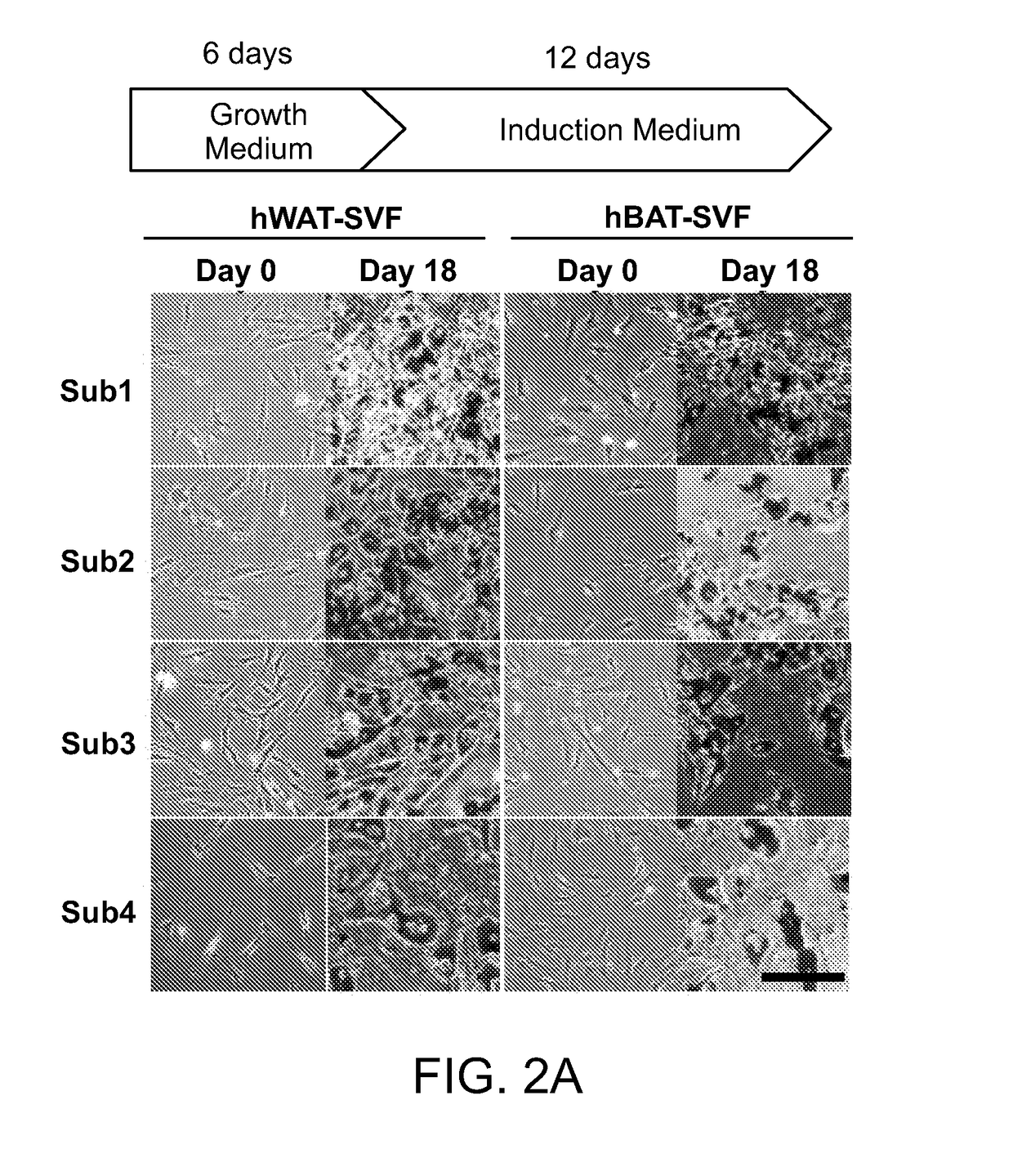Methods and compositions for promoting thermogenic potential
- Summary
- Abstract
- Description
- Claims
- Application Information
AI Technical Summary
Benefits of technology
Problems solved by technology
Method used
Image
Examples
example 1
ization of Immortalized Human BAT and WAT Progenitors
[0344]To define molecular and functional characteristics of specific adipose progenitors, human preadipocyte pooled cell populations derived from a total of four human subjects were generated by isolating cells from the stromal vascular fraction (SVF) of human neck fat and immortalizing them via stable expression of human telomere reverse transcriptase (hTert). Pairs of immortalized progenitors for human BAT (hBAT-SVF, isolated from deep neck fat) and human WAT (hWAT-SVF, isolated from superficial neck fat) of the same individuals were established from each of the four individuals for proper comparisons (Table 1). The immortalized cells were passaged in culture for more than 90 days and were followed for up to 20 population doublings (FIG. 1).
TABLE 1Clinical characteristics of subjects whose neck fat were usedfor generation of immortalized human WAT and BAT progenitorsAgeBMIPatient Code(year)Sex(kg / m2)hWATahBATaSubject 158M28.0SQb...
example 2
n of a UCP1 Reporter System for Monitoring UCP1 Expression in Vitro and In Vivo
[0350]To allow direct assessment of the thermogenic potential of differentiated cells, a transgenic reporter construct was introduced into the white and brown fat precursors to measure UCP1 gene expression by coupling a bicistronic luciferase / green fluorescent protein (GFP) reporter system to a 4.1-Kb human UCP1 promoter fragment (FIGS. 7A and 7B). In mature adipocytes which stably expressed the reporter construct, luciferase activity was strongly correlated with endogenous UCP1 gene expression and only detected in mature brown adipocytes not in undifferentiated cells (FIG. 7C). Differentiating cells were monitored using time-lapse microscopy and activation of the GFP reporter was detected as early as day 9 in differentiating BAT cells (FIG. 7D).
[0351]To determine if these cells were capable of differentiation in vivo, progenitor cells were transplanted into immune-deficient nude mice and in vivo biolumin...
example 3
alysis of Human Brown and White Fat Progenitors
[0353]In order to study homogenous cell populations derived from human adipose precursor cells, a total of 280 clonal preadipocyte cell lines (152 hWAT-SVF clones and 128 hBAT-SVF clones) were isolated from the immortalized pool populations of all four subjects. Of these lines, 44% (67 out of 152) of hWAT-SVF and 70% (90 out of 128) of hBAT-SVF clones robustly differentiated into mature adipocytes (FIG. 8A and FIG. 9). To determine UCP1 induction in the differentiated state, luciferase reporter activity was measured in each clonal line after 18-days of adipogenic differentiation (FIG. 10). The data revealed that up to 96% of the hWAT-SVF clones were UCP1 negative, while more than 94% of the hBAT-SVF clones displayed differential levels of UCP1-luciferase activities (FIG. 8A).
[0354]As shown in FIG. 2H, certain subpopulations of hWAT or hBAT precursors could respond to inductive signals, such as BMP7, to further increase their thermogenic...
PUM
 Login to View More
Login to View More Abstract
Description
Claims
Application Information
 Login to View More
Login to View More - R&D
- Intellectual Property
- Life Sciences
- Materials
- Tech Scout
- Unparalleled Data Quality
- Higher Quality Content
- 60% Fewer Hallucinations
Browse by: Latest US Patents, China's latest patents, Technical Efficacy Thesaurus, Application Domain, Technology Topic, Popular Technical Reports.
© 2025 PatSnap. All rights reserved.Legal|Privacy policy|Modern Slavery Act Transparency Statement|Sitemap|About US| Contact US: help@patsnap.com



